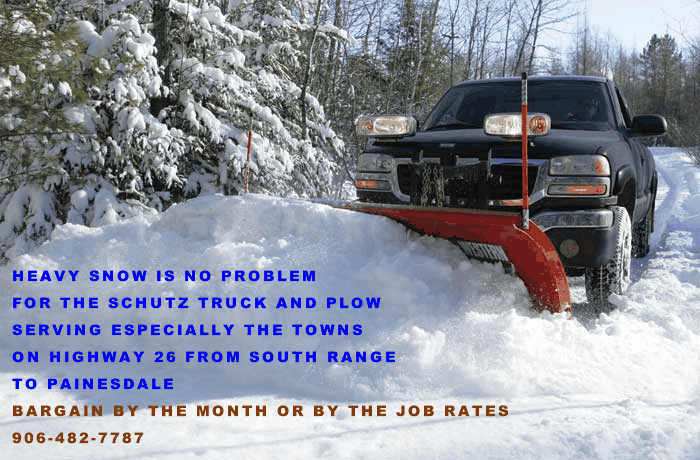Oct 15: 0 to 5 inches
Oct 31: 0 to 5 inches
Nov 15: 0 to 10 inches
Nov 30: 0 to 15 inches
Dec 15: 5 to 20 inches
Dec 31: 20 to 30 inches
Jan 15: 20 to 35 inches
Jan 31: 25 to 40 inches
Feb 15: 25 to 45 inches
Feb 28: 25 to 40 inches
Mar 15: 20 to 35 inches
Mar 31: 10 to 20 inches
Apr 15: 0 to 15 inches
Apr 30 0 to 10 inches
May 15: 0 to 5 inches
Snow depths will be in these ranges about 3/4 of the time. The once in 100 years highest possible snow depth is about 1/5 higher than the high end of the ranges shown. For example, roughly once in 100 years there might be an absolute peak of 54 inches of snow on the ground on about February 15.
USUAL SNOW DEPTH FOR THE HIGHEST PLOWED PILES OF SNOW
Note: plowing season is November 1 through April 30. Any small amount of snow that falls in May and in October is ignored by the plows because it will very quickly melt on its own. Remember, these ranges are for the HIGHEST plowed piles of snow; most plowed piles will be less high, but still much higher than the open land snow depths shown above.
Oct 15: 0 to 5 inches
Oct 31: 0 to 5 inches
Nov 15: 0 to 15 inches
Nov 30: 5 to 23 inches
Dec 15: 10 to 40 inches
Dec 31: 45 to 65 inches
Jan 15: 50 to 85 inches
Jan 31: 65 to 105 inches
Feb 15: 70 to 125 inches
Feb 28: 65 to 105 inches
Mar 15: 50 to 85 inches
Mar 31: 20 to 45 inches
Apr 15: 10 to 30 inches
Apr 30: 0 to 20 inches
May 15: 0 to 10 inches
The snow depths above are typical or average snow depths in the Trimountain / Painesdale to Mass City / Greenland stretch along Michigan highway 26. For actual current snow depths, visit the Snow Watch page.
Snow depths in other locations will range from slightly less to much less. To determine what the typical snow depths will be for a place you are interested in, follow the following procedure:
1. Go to this report. Browse the article or use your browser's find feature to find the average annual snowfall for any particular location.
2. Divide the average annual snowfall for your place of interest by 270, which is the average annual snowfall upon which the snow depths above are based.
3. Multiply the result of (2) by the minimum and maximum range numbers shown above. For example, if your location averages 216 inches a year, it would be 80% of 270. Now if I want to know what the snow depth on the general or open ground will be on January 31, I multiply .80 by the minimum and the maximum from the range shown above, which is 25 to 40. The results are 20 and 32. So now we know that there will be, in most years, between 20 and 32 inches of snow on the open ground on January 31 in the location you were interested in.
Incidentally, the calculation example we used happens to be the actual snow depth on January 31 for Houghton-Hancock, because about 80% of the snow that falls at Painesdale-Trimountain falls there.
WHEN DOES THE SNOW ON THE OPEN GROUND COMPLETELY MELT?
The open ground, not including the plowed mounds of snow, and except for a possible additional small amount of overnight spring snow that melts the next day, becomes completely green sometime during the month of April. Most commonly, it would be beeen April 10 and April 20.
Exactly when in this period the green ground returns will depend on whether there is a mid or late April snow storm, which there is slightly more than 1/2 of the years. For example, on April 21, 2009, there was an unusually late heavy snowfall of about 10 inches, which obviously caused the open ground to become snowed over again after most of it had been green for about two weeks. That snow melted rapidly, of course, but the quantity of it along with cooler than normal temperatures and mostly cloudy weather meant that it took until about the first of May for that snow to melt completely off the open ground.
WHEN DO THE PLOWED PILES OF SNOW MELT?
As for the plowed piles, which as you can see above can reach almost 10 feet high before they start coming down, are mostly melted by between April 20 and May 15, most often between April 25 and May 10. The very last little clump of plowed snow that sat in a spot that receives little sun will be gone between May 1 and May 15.




